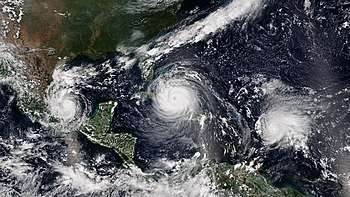Tropical cyclones and climate change
Tropical cyclones and climate change concerns how tropical cyclones have changed (in number, intensity, track or otherwise), and are expected to further change due to climate change. The topic receives considerable attention from climate scientists who study the connections between storms and climate, and notably since 2005 makes news during active storm seasons. The 2018 U.S. National Climate Change Assessment reported that "increases in greenhouse gases and decreases in air pollution have contributed to increases in Atlantic hurricane activity since 1970."[1]
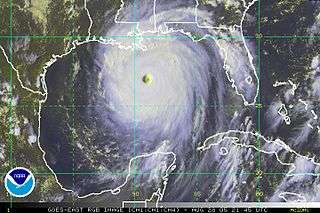
A hurricane occurs in the Atlantic Ocean and northeastern Pacific Ocean, a typhoon occurs in the northwestern Pacific Ocean, and a cyclone occurs in the south Pacific or Indian Ocean.[2] Fundamentally, they are all the same type of storm. The inclusive term used by the scientific community is tropical cyclones.
Observed trends

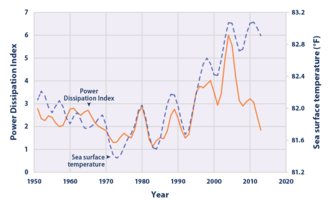
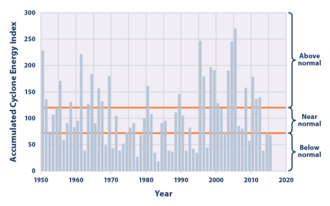
| Most intense Atlantic hurricanes | |||||
|---|---|---|---|---|---|
| Rank | Hurricane | Season | Pressure | ||
| hPa | inHg | ||||
| 1 | Wilma | 2005 | 882 | 26.05 | |
| 2 | Gilbert | 1988 | 888 | 26.23 | |
| 3 | "Labor Day" | 1935 | 892 | 26.34 | |
| 4 | Rita | 2005 | 895 | 26.43 | |
| 5 | Allen | 1980 | 899 | 26.55 | |
| 6 | Camille | 1969 | 900 | 26.58 | |
| 7 | Katrina | 2005 | 902 | 26.64 | |
| 8 | Mitch | 1998 | 905 | 26.73 | |
| Dean | 2007 | ||||
| 10 | Maria | 2017 | 908 | 26.81 | |
| Source: HURDAT[6] | |||||
The 2018 U.S. National Climate Change Assessment reports as a "key message" that "Increases in greenhouse gases and decreases in air pollution have contributed to increases in Atlantic hurricane activity since 1970."[1]
A 2010 review of related sciences found substantial uptake in the frequency of the most intense tropical cyclones, and increases in rainfall rates within 100 km of the storm centre of up to 20%.[7]
A tropical cyclone's rainfall is primarily controlled by its actual environmental sea surface temperature (SST) - relative to the tropical mean SST, called the relative sea surface temperature. The relative SST has also been identified to more precisely explain variations in Atlantic hurricane frequency, than absolute SST and tropical convection. The relative SST is defined as the SST in the TC environment minus the tropical (30°S-30°N) mean SST. Rainfall will expand outwards as the relative SST increases, associated with an expansion of a storm wind field. The largest tropical cyclones are observed in the western North Pacific tropics, where the largest values of relative SST and mid-tropospheric relative humidity are located. Flooding by TCs with global warming is projected primarily by increases in rainfall rate, rather than area extent.[8]
Measurement
Based on satellite imagery, the Dvorak technique is the primary technique used to estimate globally the tropical cyclone intensity.[9] Today measurement for a named system is also done with the ACE index (Accumulated Cyclone Energy), a wind energy index – the sum of the squares of the estimated six-hour maximum sustained wind speed in knots, to assess the storm duration and intensity. The Potential Intensity (PI) of tropical cyclones can be computed from observed data, primarily derived from vertical profiles of temperature, humidity and sea surface temperatures (SSTs). The convective available potential energy (CAPE), was computed from radiosonde stations in parts of the tropics from 1958 to 1997, but is considered to be of poor quality. The Power Dissipation Index (PDI) represents the total power dissipation for the North Atlantic and western North Pacific, and is strongly correlated with tropical SSTs.[10] Various tropical cyclone scales exist to classify a system.
Historical record
Since the satellite era, which began around 1970, trends are considered to be robust enough in regards to the connection of storms and sea surface temperatures. Agreement exists that there were active storm periods in the more distant past, but the sea surface temperature related Power Dissipation Index was not as high.[10] Paleotempestology is the science of past tropical cyclone activity by means of geological proxies (flood sediment), or historical documentary records, such as shipwrecks or tree ring anomalies.
El Niño
El Niño (ENSO) shifts the region (warmer water, up and down welling at different locations, due to winds) in the Pacific and Atlantic where more storms form, resulting in nearly constant ACE values in any one basin. The El Niño event typically decreases hurricane formation in the Atlantic, and far western Pacific and Australian regions, but instead increases the odds in the central North and South Pacific and particular in the western North Pacific typhoon region.[10]
When analyzing the correlation between extremely active tropical cyclones and El Niño events in the Eastern Pacific Ocean, it was concluded by Murakami et al. that strong El Niño events during hurricane seasons are not the only responsible factors and can most likely be attributed to greenhouse gases.[11]
Changes in number, intensity and otherwise
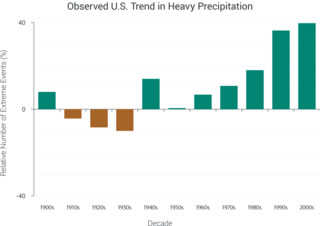
A review by Walsh et al. 2015 found good understanding of the links between climate and tropical cyclones on various timescales, with significant observed trends in the Atlantic for frequencies and intensities in the past few decades. However, these trends are still heavily studied. The authors note that the theory for maximum tropical cyclone intensity is considered well established, but with cyclone genesis still elusive. Most climate models predict fewer tropical cyclones globally, and more of the strongest storms, with increased rainfall rates.
Rainfall
Studies on increased rainfall rates are largely based on the Clausius–Clapeyron relation, which yields ≈7% increase in water vapor in the atmosphere per 1 °C warming, and the duration of storms.[12][13][14] Storm tracks indicate a global poleward expansion of the latitude at which the maximum intensity of tropical cyclones occurs.[15]
The National Climate Assessment from 2014 states:
The recent increases in activity are linked, in part, to higher sea surface temperatures in the region that Atlantic hurricanes form in and move through. Numerous factors have been shown to influence these local sea surface temperatures, including natural variability, human-induced emissions of heat-trapping gases, and particulate pollution. Quantifying the relative contributions of natural and human-caused factors is an active focus of research.[16]
The World Meteorological Organization stated 2017 that the quantity of rainfall from Hurricane Harvey had very likely been increased by climate change. The relationship between climate change and the frequency of hurricanes (or tropical cyclones) is still unclear, and is the subject of continued research.[17][18]
Overall Frequency
There is currently no consensus on how climate change will affect the overall frequency of tropical cyclones.[19] Observations have shown little change in the overall frequency of tropical cyclones worldwide.[20]
Frequency of Intense Tropical Cyclones
While trends in overall frequency are inconclusive, a greater percentage (+13%) of tropical cyclones are expected to reach Category 4 and 5 strength with 2°C warming.[19] This finding was from a study that sought to ascertain generalizations regarding how tropical cyclone activity will change if the average mean temperature of the Earth increases by 2°C.
Research conducted by Murakami et al. following the 2015 hurricane season in the eastern and central Pacific Ocean where a record number of tropical cyclones and three simultaneous category-4 hurricanes occurred, concludes that greenhouse gas forcing enhances subtropical Pacific warming which they project will increase the frequency of extremely active tropical cyclones in this area.[11]
Storm Surges
Additional sea level rise will likely increase storm surge threats.[21] A 2017 study looked at compounding effects from floods, storm surge, and terrestrial flooding (rivers), and projects an increase due to global warming.[21][22]
History
P.J. Webster and others published in 2005 an article in Science examining the "changes in tropical cyclone number, duration, and intensity" over the past 35 years, the period when satellite data has been available. Their main finding was although the number of cyclones decreased throughout the planet excluding the north Atlantic Ocean, there was a great increase in the number and proportion of very strong cyclones.[23]
According to 2006 studies by the National Oceanic and Atmospheric Administration, "the strongest hurricanes in the present climate may be upstaged by even more intense hurricanes over the next century as the Earth's climate is warmed by increasing levels of greenhouse gases in the atmosphere".[24]
The 2007 IPCC report noted many observed changes in the climate, including atmospheric composition, global average temperatures, ocean conditions, and others. The report concluded the observed increase in tropical cyclone intensity is larger than climate models predict. In addition, the report considered that it is likely that storm intensity will continue to increase through the 21st century, and declared it more likely than not that there has been some human contribution to the increases in tropical cyclone intensity.[25] The report also noted, "While attention has often been focused simply on the frequency or number of storms, the intensity, size and duration likely matter more."[10]
Studies published since 2008, by Kerry Emanuel from MIT, indicate that global warming is likely to increase the intensity but decrease the frequency of hurricane and cyclone activity.[26] In an article in Nature, Kerry Emanuel stated that potential hurricane destructiveness, a measure combining hurricane strength, duration, and frequency, "is highly correlated with tropical sea surface temperature, reflecting well-documented climate signals, including multidecadal oscillations in the North Atlantic and North Pacific, and global warming". Emanuel predicted "a substantial increase in hurricane-related losses in the twenty-first century".[27]
Research reported in the September 3, 2008 issue of Nature found that the strongest tropical cyclones are getting stronger, in particular over the North Atlantic and Indian Ocean. Wind speeds for the strongest tropical storms increased from an average of 225 km/h (140 mph) in 1981 to 251 km/h (156 mph) in 2006, while the ocean temperature, averaged globally over all the regions where tropical cyclones form, increased from 28.2 °C (82.8 °F) to 28.5 °C (83.3 °F) during this period.[28][29] The environment is much different than 50 years ago with the ocean being 1 °F warmer and melting sea ice contributing to a five to ten percentage increase in air water vapor potentially leading to more severe storms.[30]
Tropical cyclones in different basins
Hurricanes
A 2011 study linked increased activity of intense hurricanes in the North Atlantic with a northward shift and amplification of convective activities from the African easterly waves (AEWs).[31] A 2014 study investigated the response of AEWs to high emissions scenarios, and found increases in regional temperature gradients, convergence and uplift along the Intertropical Front of Africa, resulting in strengthening of the African easterly waves, affecting the climate over West Africa and the larger Atlantic basin.[32]
Studies conducted in 2008 and 2016 looked at the duration of the Atlantic hurricane season, and found it may be getting longer, particular south of 30°N and east of 75°W, or the tendency toward more early- and late-season storms, correlated to warming sea surface temperatures. However, uncertainty is still high, and one study found no trend, another mixed results.[33]
As to 2019, increasing evaporation and the larger capability of the atmosphere to hold water vapor linked to climate change, already increase the amount of rainfall from the hurricanes Katrina, Irma and Maria by 4 to 9 percent and in the future can increase it by up to 30 percent[34]
Typhoons
Research based on records from Japan and Hawaii indicate that typhoons in the north-west Pacific intensified by 12–15% on average since 1977. The observed strongest typhoons doubled, or tripled in some regions, the intensity of particular landfalling systems is most pronounced. This uptick in storm intensity affects coastal populations in China, Japan, Korea and the Philippines, and has been attributed to warming ocean waters. The authors noted that it is not yet clear to what extent global warming caused the increased water temperatures, but observations are consistent with what the IPCC projects for warming of sea surface temperatures.[35]
In July 2018 Japan experienced a natural disaster: heavy floods and landslides, who killed more than 200 people, make 2 million to flee. This was the consequence of unprecedented heavy rain and the typhoon Prapiroon. Scientist suggests, that climate change is probably one of the main cause for the disaster.[36] This is in line with government predictions for the impact of climate change on Japan. A 2012 report found that global warming could increase the risk of flooding and landslide disasters due to heavy rain.[37]
Policy response
Given the scientific consensus that tropical cyclones have been strengthening as a response to climate change, there have been numerous recommended in peer-reviewed journal articles on how best to respond. There has been grave concern that in the immediate aftermath of a tropical cyclone, the focus on applying resources towards immediate relief to those affected has and will continue to divert attention from more long-term solutions. This is further exacerbated in lower-income communities and countries as they suffer most from the consequences of tropical cyclones.[38] Despite this, in order to maintain long term stability and resilience, the implementation of long term goals cannot be understated.[38]
Policymakers have recommended certain proposed initiatives by the scientific and economic communities, and certain nations and supranational communities have already taken the initiative to either implement these or have created a plan of action to implement them in the future.[38] One active policy decision that would assist in mitigating risks of flooding would be reforestation of inland areas in order to strengthen the soil of the communities and reduce coastal inundation.[38] It is also recommended that local schools, churches, and other local community infrastructure be permanently equipped to become cyclone shelters at a moment's notice such that residents are not required to remain in their own housing for longer than absolutely necessary.[38]
Specific national and supranational decisions have already been made and are being implemented in this regard. The Framework for Resilient Development in the Pacific (FRDP) has been instituted to strengthen and better coordinate disaster response and climate change adaptation among nations and communities in the region. Specific nations such as Tonga and the Cook Islands in the Southern Pacific under this regime have developed a Joint National Action Plan on Climate Change and Disaster Risk Management (JNAP) to coordinate and execute responses to the rising risk for climate change.[38][39] These countries have identified the most vulnerable areas of their nations, generated national and supranational policies to be implemented, and provided specific goals and timelines to achieve these goals.[39] These actions to be implemented include reforestation, building of levees and dams, creation of early warning systems, reinforcing existing communication infrastructure, finding new sources of fresh water, promoting and subsidizing the proliferation renewable energy, improving irrigation techniques to promote sustainable agriculture, increase public education efforts on sustainable measures, and lobbying internationally for the increased use of renewable energy sources.[39]
United States
In the United States, there have been several concrete initiatives taken to better prepare for the strengthening of hurricanes in the foreseeable future.
North Carolina
North Carolina has been focusing on environmental issues since the 1970s when rising environmental awareness pushed the state to take advantage of the federal funds made available to states to deal with potential natural disasters in the Coastal Zone Management Act of 1972. In the interim, North Carolina has identified nine coastal areas which are most likely to suffer most in the event of hurricane activity. The state required that all municipalities and counties in these areas to prepare comprehensive action plans to be implemented and carried out in the event of a major natural disaster. The localities are further required to periodically and constantly update these action plans to keep them up to date.[40] The state requires these plans to include both long term goals to be achieved such as reforestation, building of levees, finding new fresh water sources, etc. as well as short term goals such as preparing local emergency shelters, increasing funding towards research in how best to mitigate the harm of hurricanes, stocking of emergency supplies, etc.[40]
South Carolina
In South Carolina, the state has been actively monitoring and taking an interest in hurricane aftermath management since 1977 when it passed its first coastal management act. The act was administered by the Coastal Council in the state's executive branch until 1993 when it was incorporated into the Department of Health and Environmental Control. From its inception, the South Carolina model has been management of local flora and fauna habitats to strengthen the coastal areas' resilience to flooding and storm surge from hurricanes. In 1988, the state significantly strengthened its coastal laws to deal with the increasing coastal erosion and oceanfront development. These actions came one year before the landfall of Hurricane Hugo in 1989, which devastated the state, and since then South Carolina has continued to focus on increased preparedness for ensuing hurricanes.[40] The Coastal Council's authority was amended by the legislature to provide and further enforce additional guidelines to shoreline development, which the act required be done only as a last resort. The state has also mandated planning and zoning provisions for local communities which are vulnerable to hurricane impacts, and it has required relocation of certain residents in the coastal areas to inland part of the states to prevent further loss or damage to human life.[40]

Maine
The state of Maine has a long history of coastal management in all forms dating back to the 1960s, which was then eventually codified into written law in 1978 after the "Blizzard of 1978".[40] The state passed various laws to mandate the management and preparation of state authorities to prepare for further natural disasters, including the potential landfalls of future hurricanes. The legislature allocated funds for several state executive agencies to take an active role in the regulation of coastal development and residence.[40] Maine also utilized already allocated federal funds to better manage its coastal areas. These agencies and funds were utilized to take several precautionary measures such as building sand dunes to serve as temporary levees, construction of seawalls to fortify the coast against storm surges and flooding, reforestation of the state to strengthen the soil, and the banning of construction in certain extremely flood-prone areas.[40]
Public perception
The tremendous destruction caused by recent Atlantic Ocean tropical cyclones, such as Hurricanes Katrina, Wilma, and Sandy caused a substantial upsurge in interest in the subject of climate change and hurricanes by news media and the wider public, and concerns that global climatic change may have played a significant role in those events. In 2005 and 2017, related polling of populations affected by hurricanes concluded in 2005 that 39 percent of Americans believed climate change helped to fuel the intensity of hurricanes, with 55 percent in September 2017.[41]
2005
The 2005 Atlantic hurricane season was the most active Atlantic hurricane season in recorded history, shattering numerous records. In response articles appeared in relation to climate change and hurricanes. Time Magazine, published an article titled, "Is Global Warming Fueling Katrina?".[42] Shortly after the hurricane, former Boston Globe reporter Ross Gelbspan wrote an op-ed piece for the Globe titled, "Katrina's Real Name", declaring that the hurricane's "real name is global warming." Gelbspan went on to assert:
- "Although Katrina began as a relatively small hurricane that glanced off south Florida, it was supercharged with extraordinary intensity by the relatively blistering sea surface temperatures in the Gulf of Mexico."
Gelbspan did not single out Katrina from other recent storms in that regard; in the article he went on to attribute other major weather events over the preceding year to global warming, including a blizzard in Los Angeles, high winds in Scandinavia, wildfires in Spain, and a drought centered in Missouri. Britain's then deputy prime minister, John Prescott, has linked Katrina with global warming,[43] and statements made shortly after the hurricane by Germany's environment minister, Jürgen Trittin,[44] indicate he believes that global warming is responsible for an increase in the frequency of destructive natural events.
2017
Scientists pointed out that the increase of CO
2 emissions contributes to warmer ocean waters and more moist air for rain.[45] Because of sea level rise it is assumed that the storm surge of Hurricane Irma and other storms will cause greater flooding to vulnerable areas.[45][46] Data collected by NASA showed that ocean surface temperatures in the path of Irma were above 30 °C (86 °F), capable of sustaining a Category 5 hurricane.[47]
Prior to affecting the U.S. mainland, Miami’s mayor Tomás Regalado noted on Hurricane Irma, "This is the time to talk about climate change. This is the time that the president and the EPA and whoever makes decisions needs to talk about climate change."[48] A day later the head of the EPA, Scott Pruitt said, "..to discuss the cause and effect of these storms, there’s the… place (and time) to do that, it’s not now."[49] Following Irma's landfall, Donald Trump was asked about the connection between hurricanes and climate change, and stated that "We’ve had bigger storms than this."[50]
United Nations secretary general António Guterres citing the devastation from hurricanes noted in September, "The catastrophic Atlantic hurricane season has been made worse by climate change. Cutting carbon emissions must clearly be part of our response to the disaster. The rise in the surface temperature of the ocean has had an impact on weather patterns and we must do everything possible to bring it down."[51]
See also
References
- Hayhoe, K., D.J. Wuebbles, D.R. Easterling, D.W. Fahey, S. Doherty, J. Kossin, W. Sweet, R. Vose, and M. Wehner, 2018: Our Changing Climate. In Impacts, Risks, and Adaptation in the United States: Fourth National Climate Assessment, Volume II [Reidmiller, D.R., C.W. Avery, D.R. Easterling, K.E. Kunkel, K.L.M. Lewis, T.K. Maycock, and B.C. Stewart (eds.)]. U.S. Global Change Research Program. "FOURTH NATIONAL CLIMATE ASSESSMENT Volume II: Impacts, Risks, and Adaptation in the United States". Retrieved September 7, 2019.CS1 maint: multiple names: authors list (link)
- "What is the difference between a hurricane, a cyclone, and a typhoon?". OCEAN FACTS. National Ocean Service. Retrieved 2016-12-24.
- "The Oceans Are Heating Up Faster Than Expected". scientific american. Retrieved 3 March 2020.
- "Global Annual Mean Surface Air Temperature Change". NASA. Retrieved 23 February 2020.
- IPCC AR5 SYR Glossary 2014, p. 124.
- "Atlantic hurricane best track (HURDAT version 2)" (Database). United States National Hurricane Center. May 25, 2020.
- Knutson; et al. (2010). "Tropical cyclones and climate change". Nature Geoscience. 3 (3): 157–163. Bibcode:2010NatGe...3..157K. doi:10.1038/ngeo779. hdl:1721.1/62558.
- Yanluan Lin; Ming Zhao; Minghua Zhang (2015). "Tropical cyclone rainfall area controlled by relative sea surface temperature". Nature Communications. 6: 6591. Bibcode:2015NatCo...6.6591L. doi:10.1038/ncomms7591. PMC 4382685. PMID 25761457.
- Colorado State University Tropical Meteorology Project. "Data Quality". Retrieved October 9, 2017.
- "Climate Change 2007: Working Group I: The Physical Science Basis". IPCC. 2007. Archived from the original on 2018-11-02. Retrieved 2017-10-07.
- Murakami, H., Vecchi, G., Delworth, T., Wittenberg, A., Underwood, S., Gudgel, R., Yang, X., Jia, L., Zeng, F., Paffendorf, K. & Zhang, W. (2017). "Dominant Role of Subtropical Pacific Warming in Extreme Eastern Pacific Hurricane Seasons: 2015 and the Future", JOURNAL OF CLIMATE, vol. 30, no. 1, pp. 243–264.
- Daniel B. Wright; Thomas R. Knutson; James A. Smith (2015). "Regional climate model projections of rainfall from U.S. landfalling tropical cyclones". Climate Dynamics. 45 (11–12): 3365–3379. Bibcode:2015ClDy...45.3365W. doi:10.1007/s00382-015-2544-y.
- Thomas R. Knutson; Joseph J. Sirutis; Ming Zhao (2015). "Global Projections of Intense Tropical Cyclone Activity for the Late Twenty-First Century from Dynamical Downscaling of CMIP5/RCP4.5 Scenarios". Journal of Climate. 28 (18): 7203–7224. Bibcode:2015JCli...28.7203K. doi:10.1175/JCLI-D-15-0129.1.
- Knutson; et al. (2013). "Dynamical Downscaling Projections of Late 21st Century Atlantic Hurricane Activity: CMIP3 and CMIP5 Model-based Scenarios". Journal of Climate. 26 (17): 6591–6617. Bibcode:2013JCli...26.6591K. doi:10.1175/JCLI-D-12-00539.1.
- James P. Kossin; Kerry A. Emanuel; Gabriel A. Vecchi (2014). "The poleward migration of the location of tropical cyclone maximum intensity". Nature. 509 (7500): 349–352. Bibcode:2014Natur.509..349K. doi:10.1038/nature13278. hdl:1721.1/91576. PMID 24828193.
- "Extreme Weather". National Climate Assessment.
- Tom Miles (August 29, 2017). "Storm Harvey's rainfall likely linked to climate change: U.N." Reuters. Reuters U.K. Retrieved August 31, 2017.
- "Global Warming and Atlantic Hurricanes". NOAA. 2017.
- Knutson, Thomas; Camargo, Suzana J.; Chan, Johnny C. L.; Emanuel, Kerry; Ho, Chang-Hoi; Kossin, James; Mohapatra, Mrutyunjay; Satoh, Masaki; Sugi, Masato; Walsh, Kevin; Wu, Liguang (2019-08-06). "Tropical Cyclones and Climate Change Assessment: Part II. Projected Response to Anthropogenic Warming". Bulletin of the American Meteorological Society: BAMS–D–18-0194.1. doi:10.1175/BAMS-D-18-0194.1. ISSN 0003-0007.
- "Hurricanes and Climate Change". Union of Concerned Scientists. Retrieved 2019-09-29.
- "Hurricane Harvey shows how we underestimate flooding risks in coastal cities, scientists say". The Washington Post. August 29, 2017.
- Matthew, Richard A.; Sanders, Brett F.; Aghakouchak, Amir; Salvadori, Gianfausto; Moftakhari, Hamed R. (2017). "Compounding effects of sea level rise and fluvial flooding". Proceedings of the National Academy of Sciences. 114 (37): 9785–9790. Bibcode:2017PNAS..114.9785M. doi:10.1073/pnas.1620325114. PMC 5603992. PMID 28847932.
- Webster, P. J.; Holland G.J.; Curry J.A.; Chang H.R. (2005). "Changes in Tropical Cyclone Number, Duration, and Intensity in a Warming Environment". Science. 309 (5742): 1844–1846. Bibcode:2005Sci...309.1844W. doi:10.1126/science.1116448. PMID 16166514.
- Geophysical Fluid Dynamics Laboratory. "Global Warming and Hurricanes". National Oceanic and Atmospheric Administration. Archived from the original on March 15, 2005. Retrieved November 29, 2006.
- Alley, Richard; et al. (2007). "Contribution of Working Group I to the Fourth Assessment Report of the Intergovernmental Panel on Climate Change". United Nations. Retrieved February 23, 2007.
- Emanuel, Kerry (2008). "The Hurricane-Climate Connection" (PDF). Bulletin of the American Meteorological Society. 89 (5): ES10–ES20. Bibcode:2008BAMS...89S..10E. doi:10.1175/BAMS-89-5-Emanuel. Retrieved 2009-01-19.
The weight of available evidence suggests that multidecadal variability of hurricane season tropical Atlantic SST and Northern Hemispheric surface temperature... is controlled mostly by time-varying radiative forcing owing to solar variability, major volcanic eruptions, and anthropogenic sulfate aerosols and greenhouse gases, though the response to this forcing may be modulated by natural modes of variability.
- Emanuel, Kerry (2005). "Increasing destructiveness of tropical cyclones over the past 30 years" (PDF). Nature. 436 (7051): 686–688. Bibcode:2005Natur.436..686E. doi:10.1038/nature03906. PMID 16056221. Retrieved March 20, 2006.
- Schiermeier, Q. (2008). "Hurricanes are getting fiercer". Nature. doi:10.1038/news.2008.1079.
- Warmer Seas Linked to Strengthening Hurricanes: Study Fuels Global Warming Debate. Newswise. September 3, 2008.
- Trenberth, Kevin E (2018-10-02). "Climate change caused by human activities is happening and it already has major consequences". Journal of Energy & Natural Resources Law. 36 (4): 463–481. doi:10.1080/02646811.2018.1450895. ISSN 0264-6811.
- Wang; Gillies (2011). "Observed Change in Sahel Rainfall, Circulations, African Easterly Waves, and Atlantic Hurricanes Since 1979". International Journal of Geophysics. 2011: 1–14. doi:10.1155/2011/259529.
- Christopher Bryan Skinner; Noah S. Diffenbaugh (2014). "Projected changes in African easterly wave intensity and track in response to greenhouse forcing". Proceedings of the National Academy of Sciences of the United States of America. 111 (19): 6882–6887. Bibcode:2014PNAS..111.6882S. doi:10.1073/pnas.1319597111. PMC 4024927. PMID 24778244.
- Jeff Masters (November 1, 2017). "November Atlantic Hurricane Outlook: The Season is Not Over Yet". Wunderground.
- Davidson, Jordan (July 12, 2019). "Study: Climate Change Linked to More Rain in Hurricanes". Ecowatch. Retrieved 14 July 2019.
- "Asian typhoons becoming more intense, study finds". The Guardian. 2016.
- HOPPS, KAT (12 July 2018). "Japan flooding 2018 map: Death toll rises to 200 – why so many deaths? Where did rain hit?" (Climate Change, Flooding). Express. Retrieved 25 July 2018.
- Rosane, Olivia (9 July 2018). "Historic Floods in Japan Kill More Than 100, Force Millions to Flee" (Climate Change, Flooding). Retrieved 25 July 2018.
- Thomas, Adelle; Pringle, Patrick; Pfleiderer, Peter; Schleussner, Car-Friedrich (April 14, 2017). "Topical Cyclones: Impacts, the link to Climate Change and Adaptation" (PDF). IMPACT.
- "Prevention Web".
- Moser, Susan (2005). "Impact assessments and policy responses to sea-level rise in three US states: An exploration of human-dimension uncertainties". Global Environmental Change. 15 (4): 353–369. doi:10.1016/j.gloenvcha.2005.08.002.
- "Majority of Americans now say climate change makes hurricanes more intense". The Washington Post. 2017.
- Jeffrey Kluger, Is Global Warming Fueling Katrina?, Time Magazine, Monday, August 29, 2005.
- Prescott links global warming to Katrina, Guardian Unlimited.
- German Minister Links Katrina to Global Warming, Bush Policies Archived 2008-03-17 at the Wayback Machine, CNS news, 08/31/2005.
- "Irma and Harvey should kill any doubt that climate change is real". The Washington Post. September 7, 2017.
- "Why Hurricane Irma Could Hurt, a Lot: Much Lies in Harm's Way". The New York Times. September 7, 2017.
- "Hot water ahead for Hurricane Irma". NASA Global Climate Change. September 7, 2017.
- "Miami's mayor on Hurricane Irma: 'If this isn't climate change, I don't know what is'". Miami Herald. September 8, 2017.
- "Scott Pruitt says it's not the time to talk climate change. For him, it never is". The Washington Post. September 9, 2017.
- "Trump weighs in on climate change: Hey, there have been big hurricanes before". The Washington Post. September 14, 2017.
- "UN secretary general links hurricane devastation to climate change". Climate Home. September 19, 2017.
External links
- Climate scientist describes physics behind expected increase in storm strength due to climate change (Video September 2017)
- Real-Time Global Tropical Cyclone Activity (Department Of Atmospheric Science, Colorado State University)

